How Smart Money Is Playing The $700 Billion EV Boom
China is the “800-pound gorilla” of global EV supplies, and it dominates this market in every way, including sales. Last year, China’s exports of EVs increased 131.8% YoY to some 680,000 units, based on official data. In the first half of 2023, the Chinese sold 2,093,000 EVs.
Last year’s and this year’s global EV markets are breaking all kinds of records, but China is the clear frontrunner—by miles—accounting for around 60% of global electric car sales, according to the International Energy Agency (IEA). More than half of the EVs on the roads today, are in China, and it’s already exceeded its 2025 target for new energy vehicles.
In Europe, the second largest market, EV sales rose by over 15% in 2022, while sales in the United States – the third largest market – increased 55% in 2022, reaching a global share of 8%.
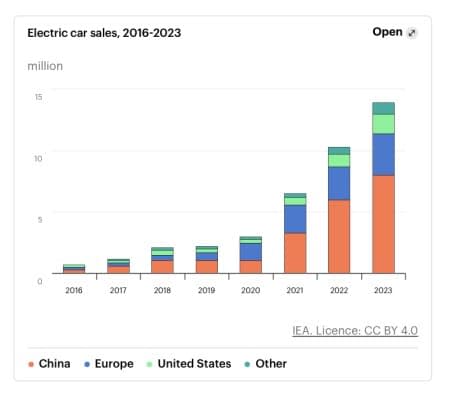
Electric vehicle sales are set for a 35% year-on-year increase in 2023, with national policies and incentives providing further impetus for producers and consumers. So far, overall, this has been rewarding for investors, especially considering that the top 14 EV stocks with only a fraction of the market capitalization of their traditional auto giant peers ended up outperforming them on the stock market.
And the next wave is in the water.
The recreational electric boat playing field is far less chaotic and crowded, and the first-mover advantage goes to Vision Marine Technologies (NASDAQ:VMAR), which offers a proprietary PowerTrain outboard motor that is being used in the launch of the fastest electric speedboat in its class on the market.
As the electric vehicle playing field shifts to the waterways, it’s not surprising to find celebrity figures such as NFL superstar Tom Brady joining in by buying an electric boat racing team for the inaugural UIM E1 World Championship, which will launch in early 2024.
But Vision Marine is already on the waterways with, with a first-of-its-kind proprietary outboard motor and powertrain powering the newly unveiled H2e Bowrider speed boat, which made its official debut in February in Miami, with deliveries set to start this summer.
The boat, developed in partnership with Four Winns, is special because it showcases VMAR’s E-Motion 180 HP electric outboard motor.
That motor, with proprietary PowerTrain technology, makes the H2e Bowrider the first all-electric series production bowrider on the market.
This is only the beginning.
VMAR’s proprietary electric motor and powertrain system can turn any boat into an electric boat.
And its sales strategy removes any notion of the unwanted cash burn that EV manufacturers are burdening investors with right now. VMAR plans to sell motors (not boats) to OEMs in an incredibly savvy move in a market flooded with struggling, cash-negative EV makers. VMAR is expecting first revenues from PowerTrain this year.
VMAR is also developing an electric system for pontoons and a major second revenue chain that involves completely flipping the massive boat rental market from ICE to electric.
With the build-out well underway, VMAR now says it is positioned to be free-cash-flow positive in 2024.
The World’s Most Powerful Electric Powertrain
Vision Marine has already made history once.
Last fall, the company broke the world electric boat speed record at 109 MPH in a 100% electric boat in the Lake of the Ozarks Shootout, the largest boating event of the year in North America.
Now, it’s about to do it again, on a journey that (in their own words) “will challenge the limits of what was thought possible”.

Armed with cutting-edge electric propulsion technology, Vision Marine (NASDAQ:VMAR), is equipping its Zenith pontoon with electric propulsion and solar panels for the longest known electric boat run in America. This month, they will embark on a 1,050-nautical-mile journey from Norfolk, Virginia, to Miami, Florida.
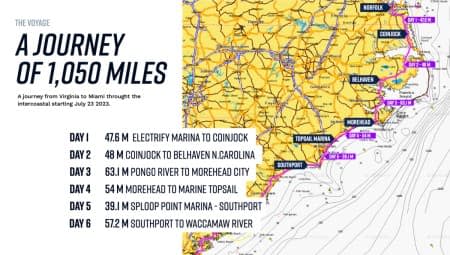
Vision Marine’s E-Motion is the first fully electric, production-ready, high-performance 180 HP outboard motor on the market.
The 180E Electric Powertrain can provide a consistent 180 HP of pure electric power, with cutting-edge high voltage power when you need it most, and a completely scalable powerbank.
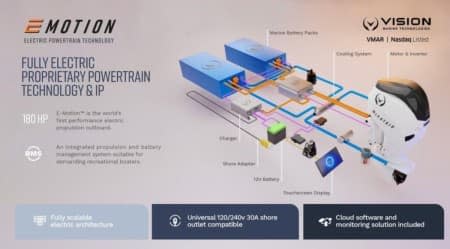
The proprietary technology is end-to-end: It includes the batteries, the engine and the software, making it the only turn-key solution for boat manufacturers in its class.
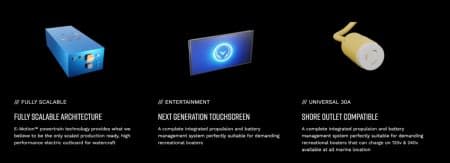
The E-Motion outboard motor can fully charge overnight with no additional infrastructure and boasts the highest horsepower engine in its class. And from a pricing perspective, it beats everyone else, which should help it to capture new market share.

For Vision Marine, this first-mover advantage is key, and it’s already received advance orders from OEMs.
Last September, right out of the gate, VMAR received an initial purchase order from the North America’s Limestone Boat Company for $2 million worth (25 units) of E-Motion 180E outboard motors and Powertrain systems. Limestone is now moving into scheduled production, with delivery target to dealers set to begin in 2024.
VMAR also plans to completely transform the massive, global boat rental market already valued at well over $18 billion and on its way to topping $30 billion by 2031.
Here, too, Vision Marine (NASDAQ:VMAR) is in a leadership position, with its flagship Newport business serving 300,000 clients in the first three years, and annualizing $4 million in revenues with a 35% profit margin. The plan for the rest of this year is to build this out with two more fully-owned electric boat rental locations and the launch of a franchise model. After that, it’s smooth sailing and all about scaling, scaling, scaling.
By the end of 2024, Nasdaq-listed Vision Marine expects to be free-cash-flow positive, and by 2025, it expects to have two profitable and growing divisions, after which the scaling is expected to gain further momentum.
The Start of a $12-Billion Transition in the Water
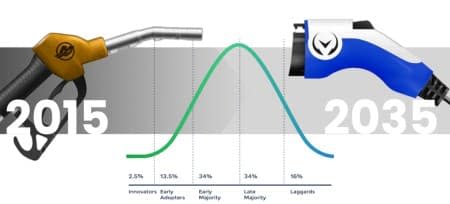
From NFL superstar Tom Brady and the first-ever electric boat racing world cup to two history-making VMAR records, the waterways are undergoing a sea change. This is the biggest transition in boating history since the first gasoline-powered outboard motors came on the market in 1896.
The global electric boat market was valued at $5 billion in 2021, and is projected to reach $16.6 billion by 2031, growing at a CAGR of 12.9% from 2022 to 2031. More specifically, the 40-foot electric boat market alone is worth $1.9 billion as of 2023, and is poised to reach $4.93 billion by 2030 for a growth rate of 14.6% over the next 8 years. The marine battery market, too, is explosive, and represents a $2-billion opportunity for investors over the next five years.
All the hype isn’t just about climate change, either—though that is the driving impetus. Water-lovers appreciate the absence of extremely noisy gasoline-powered boat motors and enjoy the peaceful quiet of electric, as well as the fact that from a safety perspective, there is no risk of gasoline leakage or carbon monoxide poisoning. Also adding to the attraction is longer-term savings, not just in gasoline, but also in maintenance costs. Electric outboard motors are said to require far less maintenance, making them cheaper overall to operate.
The world is at the beginning of a ~$12-billion transition to electric boats, and Vision Marine Technologies seems to be the frontrunner in this new, fast-moving space, breaking all kinds of records and following a sales strategy that avoids the cash-burn typical of this space.
Other EV niches to keep an eye on:
Rivian Automotive Inc. (NASDAQ: RIVN) is an American electric vehicle manufacturer that focuses on producing electric adventure vehicles. It's renowned for its all-electric pickup truck, the R1T, and its SUV, the R1S, both of which have received critical acclaim for their off-road capabilities and high-tech features. Rivian also has a contract with Amazon to deliver 100,000 electric delivery vans by 2030, marking a significant move in the electrification of commercial vehicles.
Rivian's unique positioning in the market as a maker of electric adventure vehicles distinguishes it from most other EV manufacturers, who typically focus on sedans or SUVs for urban driving. The company's focus on combining utility, off-road capabilities, and electric efficiency could resonate well with customers seeking versatile and sustainable vehicles. Additionally, its deal with Amazon indicates Rivian's potential in the broader commercial EV market.
For investors, Rivian presents a compelling opportunity in the booming EV market. While it's a relatively new player, its distinctive product offerings, commercial partnerships, and focus on sustainability could drive its growth in the coming years. However, like any start-up, Rivian faces risks associated with scale production and market acceptance of its vehicles.
Boeing Company (NYSE:BA) is one of the world's largest aerospace manufacturers and a leading producer of commercial jetliners, defense, space, and security systems. The company has been actively researching and developing technology for more sustainable aviation, which includes the exploration of electric and hybrid propulsion systems.
As part of its efforts to reduce the aviation industry's environmental impact, Boeing is working on projects related to electric planes. The company, through its subsidiary Aurora Flight Sciences, has been developing the Aurora eVTOL, an electric vertical take-off and landing aircraft, as a step towards electric air travel. This is a signal of Boeing's commitment to future electric or hybrid-electric aircraft that could transform the industry by significantly reducing emissions and noise.
For investors, Boeing's initiatives towards developing electric aircraft represent a forward-thinking approach to a greener future in aviation. If successful, this could give the company a significant edge in an industry where environmental concerns are increasingly important. However, developing electric aircraft comes with significant challenges, including technical hurdles, high development costs, and regulatory hurdles. Despite these challenges, Boeing's extensive expertise and resources put it in a good position to be a leader in this frontier of aviation technology.
Honeywell International Inc. (NYSE:HON) is a multinational conglomerate with diverse operations, including aerospace, building technologies, performance materials, and safety. While not a traditional player in the automotive industry, Honeywell has entered the EV market through its Honeywell Transportation Systems division, which provides parts such as turbochargers for many different vehicle manufacturers. The company has begun developing new technologies to support the electric vehicle market, such as advanced cooling solutions for electric vehicle chargers.
In addition, Honeywell's expertise in automation and efficiency can help automakers and suppliers optimize the manufacturing of electric vehicles and their components. This indirect involvement in the EV boom highlights how the transition to electric vehicles has implications for a wide range of industries, not just automakers.
For investors, Honeywell offers exposure to the EV market while providing the stability of a diversified, established company. Honeywell's innovative technologies, combined with its wide-ranging operations, provide a unique proposition in the rapidly evolving electric vehicle market.
REV Group, Inc. (NYSE:REVG) is a leading manufacturer of specialty vehicles, including buses, fire trucks, ambulances, and recreational vehicles. It operates through three segments: Fire & Emergency, Commercial, and Recreation. While traditionally known for their diesel and gas-powered vehicles, REV Group has also made strides in the electric vehicle market.
In response to the increasing demand for sustainable transportation solutions, REV Group has started to offer electric versions of some of its vehicles. For instance, the company has introduced zero-emission, all-electric buses, such as the ENC Axess Electric Bus, which are used in public transit across numerous cities in the US. These electric buses help cities reduce their carbon footprint, and with the growing focus on sustainable public transport, this sector of their business is expected to grow.
For investors, REV Group offers an interesting proposition. It's a well-established company that's capitalizing on the ongoing EV boom by offering electric versions of its specialty vehicles. It's uniquely positioned in the EV market, focusing on the niche of electric emergency and commercial vehicles, which could give it a competitive advantage. However, investors should consider the capital-intensive nature of the specialty vehicle industry and the challenge of transitioning from traditional powertrains to electric ones. The successful execution of REV Group's electrification strategy will be key to its future growth.
EHang Holdings Limited (NASDAQ:EH) is a Chinese autonomous aerial vehicle (AAV) technology platform company. It is one of the world's leading autonomous drone technology companies and is shaping the future of transport with its advanced electric autonomous aerial vehicles. The company's products include passenger-grade AAVs, cargo AAVs, and city air mobility (UAM) systems.
EHang's passenger-grade AAV, the EHang 216, is a revolutionary product in the electric vehicle market. It's a two-seater, 16-rotor autonomous drone capable of transporting people through the air, marking a shift from traditional road-focused electric vehicles to a future of air mobility. EHang also focuses on developing the infrastructure to support widespread use of AAVs, including command-and-control systems and vertiports.
For investors, EHang represents an exciting opportunity in the EV market, expanding beyond traditional road vehicles into the realm of electric aerial vehicles. The company's pioneering work in autonomous aerial transportation has the potential to transform urban transport and logistics. However, investing in EHang also comes with unique risks related to regulatory approval, technology development, and market acceptance of AAVs. It's an investment in a bold vision of the future, but like all innovative technology companies, there are uncertainties and challenges that EHang must navigate to achieve its goals.
QuantumScape Corporation (NYSE:QS) is a developer of next-generation solid-state lithium-metal batteries for use in electric vehicles. The company's proprietary technology aims to significantly improve the energy density and charging speed of batteries while enhancing safety by eliminating the flammable liquid electrolyte found in conventional lithium-ion batteries.
QuantumScape's focus on solid-state batteries places it at the forefront of a potential revolution in battery technology, key to the EV market. If successful, solid-state batteries could address some of the biggest challenges facing electric vehicles, such as range anxiety and long charging times, thereby accelerating the adoption of EVs.
For investors, QuantumScape could represent a strategic investment in the future of EV technology. As the electric vehicle market grows, the demand for advanced battery technology is set to rise. However, investors should be aware that QuantumScape's technology is still in the developmental stages, and commercialization has its challenges and is still a few years away.
Solid Power, Inc. (NASDAQ:SLDP) is another player in the race to develop solid-state batteries for electric vehicles. The company is backed by several big names in the automotive industry, including Ford and BMW, a testament to the potential of its technology. By replacing the liquid electrolyte in traditional lithium-ion batteries with a solid one, Solid Power's batteries could potentially offer higher energy density, improved safety, and lower costs.
As the EV market continues to grow, the need for improved battery technology becomes increasingly urgent. Solid Power's promising technology could be a game-changer, improving the viability and consumer appeal of electric vehicles.
Investors interested in the EV market should consider Solid Power as a potential investment in the EV supply chain. The company's strong industry partnerships and the increasing demand for advanced batteries make it an interesting proposition. However, like any company working on cutting-edge technology, Solid Power faces technical challenges and will need to successfully commercialize its technology to succeed.
Magna International Inc. (NYSE:MG) plays a significant role in the EV industry as a supplier rather than a manufacturer. The company is involved in many aspects of vehicle electrification, from powertrain systems to vehicle assembly. Magna's comprehensive range of services makes it a crucial partner for many automakers transitioning to electric vehicles.
In addition, Magna is investing in next-gen technology, from advanced driver-assistance systems (ADAS) to solid-state lidar. Its commitment to tech innovation allows it to support automakers not just with current needs but also future demands. Investors should consider Magna's potential as it leverages its broad customer base and wide-ranging capabilities to grow in an industry transitioning towards electric and autonomous vehicles.
Although not directly an EV manufacturer, Westport Fuel Systems Inc.'s (NASDAQ:WPRT) work in developing advanced fuel systems is crucial to the transition towards sustainable transportation. The company is a leader in clean-burning, low-emission engine and fuel system technologies, helping commercial vehicles and heavy-duty truck manufacturers reduce their environmental impact.
By offering technology that can transition vehicles towards cleaner fuels, Westport occupies a unique position in the market. Its systems are crucial in the drive towards reducing greenhouse gas emissions and reliance on petroleum fuels. For investors, Westport represents an opportunity to invest in the broader ecosystem supporting the shift to cleaner, more efficient transportation.
Ballard Power Systems Inc. (NASDAQ:BLDP) is a global leader in fuel cell technology, a crucial component for electric vehicle systems, particularly in commercial applications like buses, trucks, and trains. Ballard's proton exchange membrane (PEM) fuel cells are highly efficient, durable, and suited for electrification of commercial vehicles, where longer range and quick refuelling are essential.
Ballard is also leading innovation in fuel cell drones, which can offer significant advantages over battery-electric systems in terms of flight time and payload capacity. For investors, Ballard's leading position in the fuel cell market and its broad application across various commercial vehicles and drones offer significant potential as the demand for cleaner, efficient power solutions grows.
By. Tom Kool
IMPORTANT NOTICE AND DISCLAIMER
This communication is a paid advertisement. Oilprice.com and its owners, managers, employees, and assigns (collectively “the Publisher”) is occasionally paid by one or more of the profiled companies or a third party to disseminate these types of communications. In this case, the Publisher has been compensated by Vision Marine Technologies Inc (NASDAQ:VMAR) to conduct investor awareness advertising and marketing. Vision Marine paid the owner of Oilprice.com an out-of-the-money Common Share Purchase Warrant entitling the owner of Oilprice to purchase 250,000 shares of common stock between August 21, 2023 and February 21, 2026 at a price of USD $4.21 per share. This compensation should be viewed as a major conflict with our ability to be unbiased.
Readers should beware that third parties, profiled companies, and/or their affiliates may liquidate shares of the profiled companies at any time, including at or near the time you receive this communication, which has the potential to hurt share prices. Frequently companies profiled in such articles experience a large increase in volume and share price during the course of investor awareness marketing, which often ends as soon as the investor awareness marketing ceases. The investor awareness marketing may be as brief as one day, after which a large decrease in volume and share price may likely occur.
This communication is not, and should not be construed to be, an offer to sell or a solicitation of an offer to buy any security. Neither this communication nor the Publisher purport to provide a complete analysis of any company or its financial position. The Publisher is not, and does not purport to be, a broker-dealer or registered investment adviser. This communication is not, and should not be construed to be, personalized investment advice directed to or appropriate for any particular investor. Any investment should be made only after consulting a professional investment advisor and only after reviewing the financial statements and other pertinent corporate information about the company. Further, readers are advised to read and carefully consider the Risk Factors identified and discussed in the advertised company’s SEC, SEDAR and/or other government filings. Investing in securities, particularly microcap securities, is speculative and carries a high degree of risk. Past performance does not guarantee future results. This communication is based on information generally available to the public and on an interview conducted with the company’s CEO, and does not contain any material, non-public information. The information on which it is based is believed to be reliable. Nevertheless, the Publisher cannot guarantee the accuracy or completeness of the information.
SHARE OWNERSHIP. The owner of Oilprice.com owns shares and/or stock options of the featured company and therefore has an additional incentive to see the featured companies’ stock perform well. The owner of Oilprice.com has no present intention to sell any of the issuer’s securities in the near future but does not undertake any obligation to notify the market when it decides to buy or sell shares of the issuer in the market. The owner of Oilprice.com will be buying and selling shares of the featured company for its own profit. This is why we stress that you conduct extensive due diligence as well as seek the advice of your financial advisor or a registered broker-dealer before investing in any securities.
FORWARD LOOKING STATEMENTS. This publication contains forward-looking statements, including statements regarding expected continual growth of the featured companies and/or industry. The Publisher notes that statements contained herein that look forward in time, which include everything other than historical information, involve risks and uncertainties that may affect the companies’ actual results of operations. Factors that could cause actual results to differ include, but are not limited to, changing governmental laws and policies impacting the company’s business, the size and growth of the market for the companies’ products and services, the companies’ ability to fund its capital requirements in the near term and long term, pricing pressures, etc.
INDEMNIFICATION/RELEASE OF LIABILITY. By reading this communication, you acknowledge that you have read and understand this disclaimer, and further that to the greatest extent permitted under law, you release the Publisher, its affiliates, assigns and successors from any and all liability, damages, and injury from this communication. You further warrant that you are solely responsible for any financial outcome that may come from your investment decisions.
TERMS OF USE. By reading this communication you agree that you have reviewed and fully agree to the Terms of Use found here http:// Oilprice.com/terms-and-conditions If you do not agree to the Terms of Use http:// Oilprice.com/terms-and-conditions, please contact Oilprice.com to discontinue receiving future communications.
INTELLECTUAL PROPERTY. Oilprice.com is the Publisher’s trademark. All other trademarks used in this communication are the property of their respective trademark holders. The Publisher is not affiliated, connected, or associated with, and is not sponsored, approved, or originated by, the trademark holders unless otherwise stated. No claim is made by the Publisher to any rights in any third-party trademarks.
